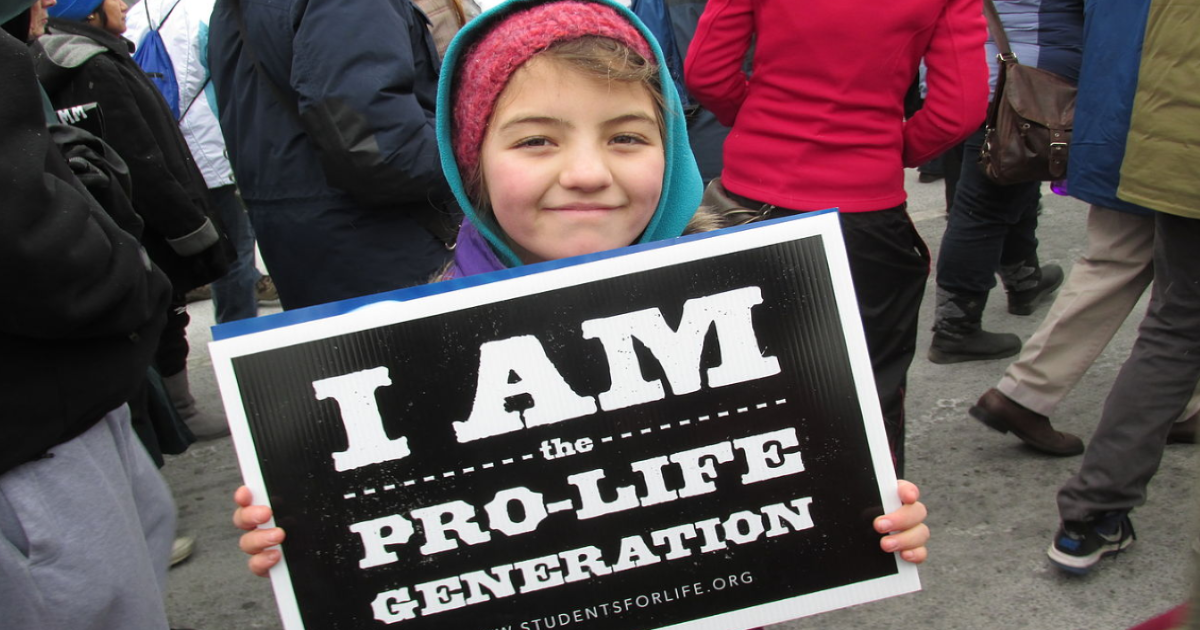


At the huge March for Life in Washington, DC, last week, we often had to wait patiently for the mass of people to move forward as we headed for the U.S. Supreme Court—the origin point, in 1973, of an infamous decision that forced all 50 states to strip protections from babies still occupying their mothers’ womb.
Some of the marchers waited a bit less patiently. At every pause in the marching, a dozen balls went sailing high into the air as marchers began impromptu volleyball games along Constitution Avenue.
As I watched them zestfully bouncing the balls, I realized that I was seeing the face of the modern prolife movement: Kids.
There were kids everywhere, chanting, clapping, singing, and waving signs. Kristi Hamrick, a spokesperson for Students for Life, says that last week, her organization trained and mobilized more young people on a single day—some 3,000—than Planned Parenthood trained in a year, according to its annual report. These kids know that a quarter of their generation was lost to abortion—kids with whom they might have played video games, walked to school, or fallen in love.
Their enthusiasm should not surprise us. Polls consistently show that young people are more prolife than their parents. Fifty-eight percent of 18- to 29-year olds—believe that killing the unborn is morally wrong. This is a promising increase over the number of previous generations–who say abortion is wrong (51 percent). And the percentage is likely to go higher. This must surely dismay those who make their living executing fetuses and selling them for parts.

I have to wonder if a shiver goes through them—especially children of single mothers who struggle to pay the bills. Do they think, “I’m lucky to be alive?”As for adoptees--these children, especially, must realize they dodged a bullet.
I am old enough to remember the early days of the prolife movement. In the 1970s, the abortion lobby dismissed “anti-choicers” as a bunch of deranged Catholics who wanted to foist the Church’s “backward” teachings on all Americans. Their outdated opinions, or so abortion supporters thought, would soon be supplanted by the more sensible views of progressive, educated young people.
When pro-abortion journalists invited prolifers on their television talk shows, they ignored well-spoken young women trained to answer tricky questions and invited instead elderly priests and ministers, many of whom were not as experienced as they might have been at dealing with hostile journalists. Again, the message was: Only old, religious people oppose abortion.
But they didn’t count on what would happen when children born after Roe grew up and learned about abortion—kids who realized that millions of their cohorts did not survive their mothers’ choice. Having been born before Roe, I can only speculate about how this feels.
But I have to wonder if a shiver goes through them—especially children of single mothers who struggle to pay the bills. Do they think, “I’m lucky to be alive?”As for adoptees–these children, especially, must realize they dodged a bullet.
Their adoptive parents know their kids are lucky to be alive. At the March for Life, I stood with a friend who was helping hold up a banner reading “Choose Adoption.” People approached us all afternoon, telling us how much they appreciated this message.
One young father, who, with his wife, adopted two children, told me that one of his kids was the child of a rape victim. How grateful he was that his son’s biological mother had made the brave choice. How deeply his life, and his wife’s life, had been enriched by her decision.

When pregnant women see sonogram images of somersaulting babies who suck their thumbs, yawn, and hiccup, many of them decide to give birth—even women in difficult circumstances who came in the door convinced that abortion was their only option.
Another thing the abortion industry did not count on: The great advance in ultrasound technology, which exposed “pro-choice” lies about fetuses being nothing but clumps of tissue.
When pregnant women see sonogram images of somersaulting babies who suck their thumbs, yawn, and hiccup, many of them decide to give birth—even women in difficult circumstances who came in the door convinced that abortion was their only option.
The abortion lobby likely thought we would eventually give up and go home. It must be so frustrating for them to see these massive marches—an estimated 300,000 strong this year—nearly five decades after the Supremes “decided” this issue. It must be especially irritating to see young, smart, well-educated kids saying, “Abortion is wrong, and our generation is going to put an end to it.”
This is why I was so happy to see those balls being tossed in the air at the March for Life this year, and why I was amused instead of annoyed when one of the balls nearly slammed into my head (I batted it back to the kids). I love their energy and enthusiasm. I love the way they are already doing so much, on their campuses, to help students with unplanned pregnancies.
They are the future of the prolife movement—the Prolife Generation, as they call themselves: Kids determined to wipe out abortion violence, and see all babies, in all circumstances, welcomed into life outside the womb.
Image: Google Images














